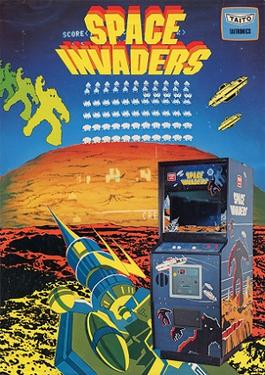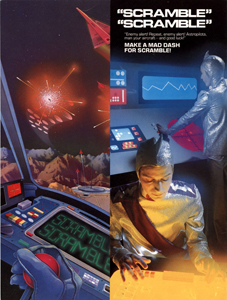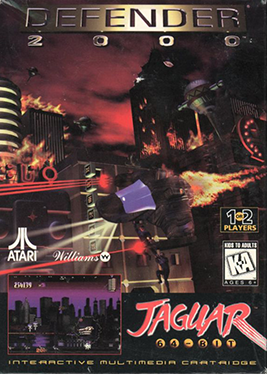Related Research Articles

Space Invaders is a 1978 shoot 'em up arcade video game, developed and released by Taito in Japan and licensed to Midway Manufacturing for overseas distribution. Commonly considered to be one of the most influential video games of all time, Space Invaders was the first fixed shooter and set the template for the genre. The goal is to defeat wave after wave of descending aliens with a horizontally moving laser cannon to earn as many points as possible.

Joust is an action game developed by Williams Electronics and released in arcades in 1982. While not the first two-player cooperative video game, Joust's success and polished implementation popularized the concept. Players assume the role of knights armed with lances and mounted on large birds, who must fly around the screen and defeat enemy knights riding buzzards.
Shoot 'em ups are a sub-genre of action games. There is no consensus as to which design elements compose a shoot 'em up; some restrict the definition to games featuring spacecraft and certain types of character movement, while others allow a broader definition including characters on foot and a variety of perspectives.

Scramble is a horizontally scrolling shooter arcade video game released in 1981. It was developed by Konami and manufactured and distributed by Leijac in Japan and Stern in North America. It was the first side-scrolling shooter with forced scrolling and multiple distinct levels, and it established the foundation for a new genre.

Defender is a horizontally scrolling shooter developed by Williams Electronics in 1980 and released as an arcade video game in 1981. The game is set on either an unnamed planet or city where the player must defeat waves of invading aliens while protecting astronauts. Development was led by Eugene Jarvis, a pinball programmer at Williams; Defender was Jarvis's first video game project and drew inspiration from Space Invaders and Asteroids. Defender was demonstrated in late 1980, before entering production in early 1981. It was distributed in Japan by Taito.

Stargate is a horizontally scrolling shooter released as an arcade video game in 1981 by Williams Electronics. Created by Eugene Jarvis and Larry DeMar, it is a sequel to Defender which was released earlier in the year. It was the first of only three productions from Vid Kidz, an independent development house formed by Jarvis and DeMar. Some home ports of Stargate were renamed to Defender II for legal reasons.

Robotron: 2084 is a multidirectional shooter developed by Eugene Jarvis and Larry DeMar of Vid Kidz and released in arcades by Williams Electronics in 1982. The game is set in the year 2084 in a fictional world where robots have turned against humans in a cybernetic revolt. The aim is to defeat endless waves of robots, rescue surviving humans, and earn as many points as possible.

Eugene Peyton Jarvis is an American game designer and video game programmer, known for producing pinball machines for Williams Electronics and video games for Atari. Most notable among his works are the seminal arcade video games Defender and Robotron: 2084 in the early 1980s, and the Cruis'n series of driving games for Midway Games in the 1990s. He co-founded Vid Kidz in the early 1980s and currently leads his own development studio, Raw Thrills Inc. In 2008, Eugene Jarvis was named the first Game Designer in Residence by DePaul University's Game Development program. His family owns the Jarvis Wines company in Napa, California.
The golden age of arcade video games was the period of rapid growth, technological development, and cultural influence of arcade video games from the late 1970s to the early 1980s. The release of Space Invaders in 1978 led to a wave of shoot-'em-up games such as Galaxian and the vector graphics-based Asteroids in 1979, made possible by new computing technology that had greater power and lower costs. Arcade video games switched from black-and-white to color, with titles such as Frogger and Centipede taking advantage of the visual opportunities of bright palettes.

Cruis'n USA is an arcade racing game originally released in 1994. It was developed by Eugene Jarvis' company TV Games Inc., and manufactured by Midway Games. It is the first game in the Cruis'n series and features races set in locations across the continental United States.
Fueled by the previous year's release of the colorful and appealing Pac-Man, the audience for arcade video games in 1981 became much wider. Pac-Man influenced maze games began appearing in arcades and on home systems. Pac-Man was the highest grossing video game for the second year in a row. Nintendo's Donkey Kong defined the platform game genre, while Konami's Scramble established scrolling shooters. The lesser known Jump Bug combined the two concepts into both the first scrolling platform game and the first platform shooter. Other arcade hits released in 1981 include Defender, Frogger, and the Galaxian sequel Galaga.
1980 saw the release of a number of games with influential concepts, including Pac-Man, Battlezone, Crazy Climber, Mystery House, Missile Command, Phoenix, Rally-X, Space Panic, Stratovox, Zork, Adventure, and Olympic Decathlon. The year's highest-grossing video game was Namco's arcade game Pac-Man, while the best-selling home system was Nintendo's Game & Watch. The Atari VCS also grew in popularity with a port of Space Invaders and support from new third-party developer Activision.

Narc is a 1988 run and gun arcade game designed by Eugene Jarvis for Williams Electronics and programmed by George Petro, Todd Allen, and Eugene Jarvis, with art by Jack Haeger, John Newcomer, and Lin Young. It was one of the first ultra-violent video games and a frequent target of parental criticism of the video game industry. The object is to arrest and kill drug offenders, confiscate their money and drugs, and defeat "Mr. Big". It was the first game in the newly restarted Williams Electronics coin-op video game division. Shortly before its release, Williams acquired the video and pinball divisions of Bally/Midway.
Blaster is a first-person rail shooter released as an arcade video game by Williams Electronics in 1983. It was developed by Eugene Jarvis and Larry DeMar. A vague sequel to Robotron: 2084, the game is a shoot 'em up set in outer space. The goal is to destroy enemies, avoid obstacles, and rescue astronauts in twenty levels, to reach paradise.
A side-scrolling video game is a game viewed from a side-view camera angle where the screen follows the player as they move left or right. The jump from single-screen or flip-screen graphics to scrolling graphics during the golden age of arcade games was a pivotal leap in game design, comparable to the move to 3D graphics during the fifth generation.

Defender 2000 is a 1996 scrolling shooter video game developed by Llamasoft and published by Atari Corporation for the Atari Jaguar. Part of Atari's 2000 series of arcade game revivals, it is an update of Eugene Jarvis' arcade game Defender (1981). The premise takes place in a future where the Alpha Promixian empire attack mining settlements on distant resource planets. Gameplay is divided into three modes, with the player acting as part of the System Defense Team commanding the Threshold ship to defeat waves of invading aliens while protecting humans.

Lawrence E. "Larry" DeMar is an American video game and pinball designer and software programmer. He is known as co-designer, alongside Eugene Jarvis, of the classic arcade games Defender and Robotron: 2084.

Rawson Law Stovall is an American video game designer and producer. He started out as a video game journalist, the first to be nationally syndicated in the United States. In 1982, ten-year-old Stovall's first column appeared in the Abilene Reporter-News, his local newspaper. He got the column in ten publications before Universal Press Syndicate started distributing it in April 1983; by 1984, the column, titled "The Vid Kid", appeared in over twenty-four newspapers. After being reported on by The New York Times, Stovall was featured on The Tonight Show Starring Johnny Carson and earned a regular spot on Discovery Channel's The New Tech Times. In 1985, he helped introduce the Nintendo Entertainment System at its North American launch.
Twin-stick shooter is a subgenre of shoot 'em up video games. It is a multidirectional shooter in which the player character is controlled using two joysticks: the first for movement on a flat plane and the second to shoot in the direction the joystick is pushed. Usually shots are fired as soon as the second joystick is moved, but in some games there is an additional button which must be held. Keyboard and mouse or touch input may supplant one or both joysticks. A few games, such as 1981's Vanguard, don't have a second joystick for shooting, but provide four buttons arranged in a diamond to fire in the cardinal directions.
References
- ↑ Steven L. Kent (2000). The First Quarter: A 25-Year History of Video Games. p. 181. ISBN 9780970475503.
- ↑ Len Albin (1982). Secrets of the video game super stars. p. 13. ISBN 0380806142.
- ↑ Mark J. P. Wolf (2012). Before the Crash: Early Video Game History. p. 164. ISBN 978-0814337226.